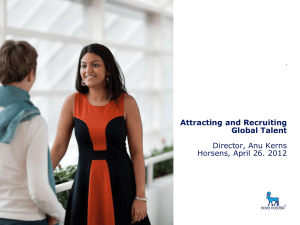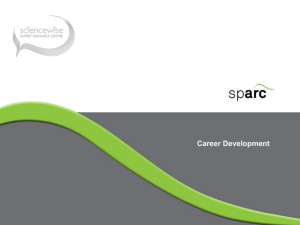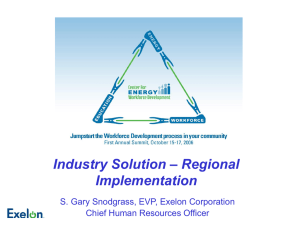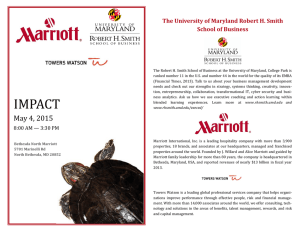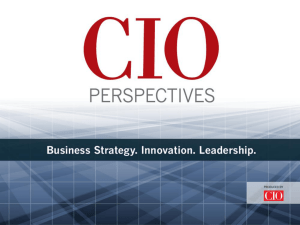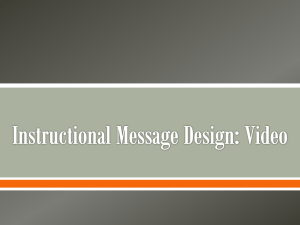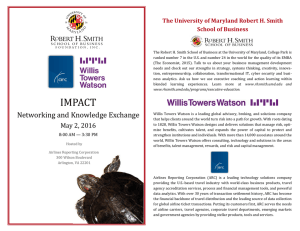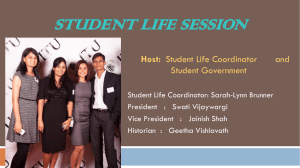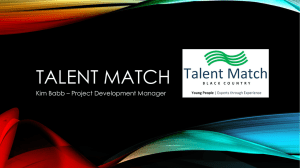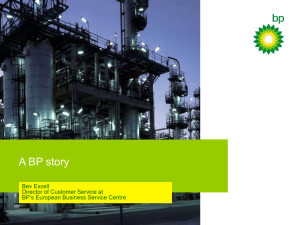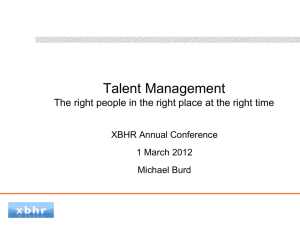New Era for Talent Management
advertisement
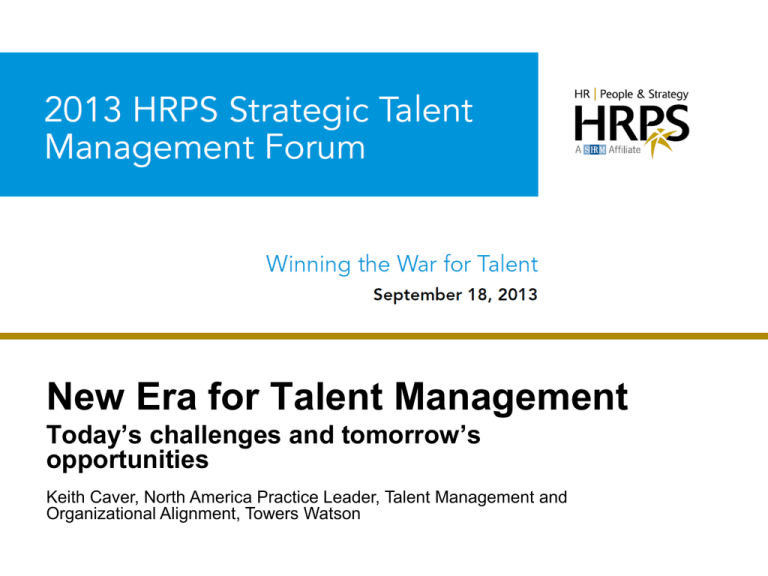
Strategic Talent Management Forum New Era for Talent Management Today’s challenges and tomorrow’s opportunities Keith Caver, North America Practice Leader, Talent Management and Organizational Alignment, Towers Watson Difficulty finding the right people and keeping the people you need Problems Attracting Problems Retaining Critical skill employees 72% 56% High potential employees 60% 55% Top-performing employees 59% 50% All employees 31% 25% Workforce Segment Source: Towers Watson 2012-2013 Global Talent Management and Rewards Study — Global. 2 0 1 3 S T R A T E G I C T A L E N T M A N A G E M E N T F O R U M “ Engagement is at risk. It’s not about ‘feeling good’…it’s about having the tools, colleagues, “ time, capacity to fully commit to work. - Towers Watson 2012 Global Workforce Study 2 0 1 3 S T R A T E G I C T A L E N T M A N A G E M E N T F O R U M The current state of sustainable engagement of the global workforce Source: Towers Watson 2012 Global Workforce Study — Global. 2 0 1 3 S T R A T E G I C T A L E N T M A N A G E M E N T F O R U M Further complicating these challenges are other talent realities Security Structural mismatches Friction points Skill gaps Unsustainability 2 0 1 3 S T R A T E G I C T A L E N T M A N A G E M E N T F O R U M The next critical skills global skills agile thinking relationship building digital business skills 2 0 1 3 S T R A T E G I C T A L E N T M A N A G E M E N T F O R U M A deeper look at the emerging skill sets Global skills Agile thinking Dealing with complexity and ambiguity Foreign language skills Ability to manage diverse employees Ability to consider and prepare for multiple scenarios Ability to work in multiple overseas locations Innovation Cultural sensitivity Managing paradoxes, balancing opposing views Understanding international markets Ability to see the “big picture” 0 10 20 30 40 % of respondents 50 0 60 Digital business skills Relationship building (with customers, partners, government, etc.) Ability to work virtually Teaming (including virtual teaming) Understanding of corporate IT software and systems Collaboration Digital design skills Co-creativity and brainstorming Ability to use social media and “Web 2.0” Oral and written communication 10 20 30 40 50 % of respondents 20 30 40 50 % of respondents 0 60 10 20 30 40 50 60 70 % of respondents Source: Global Talent 2021 Study conducted by Oxford Economics and Towers Watson, 2012. 2 0 1 3 S 60 Relationship building Digital business skills 0 10 T R A T E G I C T A L E N T M A N A G E M E N T F O R U M Future talent friction points Deficit countries At equilibrium Surplus countries Source: Global Talent 2021 Study conducted by Oxford Economics and Towers Watson, 2012. 2 0 1 3 S T R A T E G I C T A L E N T M A N A G E M E N T F O R U M Global forces and trends are changing demands on employers and employees Dramatic shifts in skill requirements for future growth, coupled with increasing misalignment between supply of/demand for talent worldwide GWS Talent 2021 Dispersed and diverse workforce, enabled by technology to work anywhere, anytime, across national/organizational boundaries in increasingly innovative work arrangements Transformative HR Ongoing cost pressures and continual belt-tightening in most markets, increasing employers’ focus on maximizing workforce productivity TM&R Pressured, stressed workforce, struggling to do more with less, looking for long-term security and stability in a world that isn’t offering much of either 2 0 1 3 S T R A T E G I C T A L E N T M A N A G E M E N T F O R U M What are the strategic implications? technology Sustainability Creative sourcing 2 0 1 3 S T R A T E G I C T A L E N T M A N A G E M E N T F O R U M How to respond Grow and develop Hire more from outside Retain key people Raise engagement Improve performance 2 0 1 3 S T R A T E G I C T A L E N T M A N A G E M E N T F O R U M Savvy employers will need to think differently about their practices in the future Apply the same rigor, effort and sophistication to human capital planning as to business planning Business rigor 2 0 1 3 Think more broadly Embrace the virtual Invest more heavily – and creatively – workplace and in retraining and about where support a wide reskilling talent is sourced range of different work scenarios Talent sourcing S T R A T E G I C Virtual workplace T A L E N T Re-skilling M A N A G E M E N T Rethink and restructure how certain work is accomplished Rethinking work F O R U M Our latest research Sustainable engagement • Engagement is at risk • Pay continues to be major headline, but career advancement is the new retention risk • Talent Paradigm – know the critical roles for future business success; know your critical talent ; focus your interventions on those holding critical roles, or your talent that shows critical potential – SEGMENTATION • MIND THE GAP – about EE/ER differences and about growing engagement gap 2 0 1 3 S T R A T E G I C T A L E N T M A N A G E M E N T F O R U M Behind these numbers are gaps in areas particularly relevant in today’s environment Traditionally Engaged Enablement Energy Belief in company goals and objectives Freed from obstacles to succeed at work Can sustain energy needed at work Emotional connection (pride, recommendation) Have resources to perform well Have social supports in work environment Willingness to give extra effort to support success Can meet work challenges effectively Have sense of enthusiasm and accomplishment at work Ensuring people are capable of doing their jobs well 2 0 1 3 S T R A T E G I C T A L E N T M Ensuring people have capacity to perform at their best A N A G E M E N T F O R U M The payoff for closing gaps in the drivers of sustainable engagement is substantial 3x operating margin High sustainable engagement companies’ operating margins are 3x higher than those with the lowest levels of engagement 6.5 fewer days lost An average of 7.6 days of lost productivity per year for employees with high engagement vs. 14.1 days for the disengaged 41% lower retention risk Only 17% of employees with high engagement are high retention risks compared to 58% of disengaged employees Source: Towers Watson normative database. 2 0 1 3 S T R A T E G I C T A L E N T M A N A G E M E N T F O R U M The top drivers are influenced by an employer’s value proposition, EVP, and Total Rewards programs Top Drivers of Sustainable Engagement 1 2 Leadership Effective at growing the business Sincere interest in employees’ well-being Behave consistently with organization’s core values Trust and confidence in job being done 3 4 Goals and Objectives Good understanding of organization’s business goals and steps needed to reach those goals Understanding of how job contributes to the organization achieving its business goals 5 Stress, Balance and Workload Stress levels at work are manageable Healthy balance between work and personal life Work arrangements are flexible Enough employees in work group to get job done right Supervision Treats me with respect Encourages new ideas and ways of doing things Acts in ways consistent with his or her words Effective career development conversations Image Organization highly regarded by general public Organization conducts its business with honesty and integrity Source: Towers Watson 2012 Global Workforce Study — Global. 2 0 1 3 S T R A T E G I C T A L E N T M A N A G E M E N T F O R U M Differentiate to attract and retain Use the employee value proposition to drive the right behaviors and performance. Differentiate for key employee groups. 2 0 1 3 S T R A T E G I C T A L E N T M A N A G E M E N T F O R U M A formalized EVP helps organizations address critical challenges with attraction, retention and engagement of talent 5X Companies that have adopted an increasingly integrated approach to Total Rewards strategy, design and delivery decisions — supported by an overarching Employee Value Proposition — are: 2 0 1 3 S T R A T E G I C T A L E N T more likely to report their employees are highly engaged 2X more likely to report achieving financial performance significantly above their peers M A N A G E M E N T F O R U M Questions 2 0 1 3 S T R A T E G I C T A L E N T M A N A G E M E N T F O R U M
